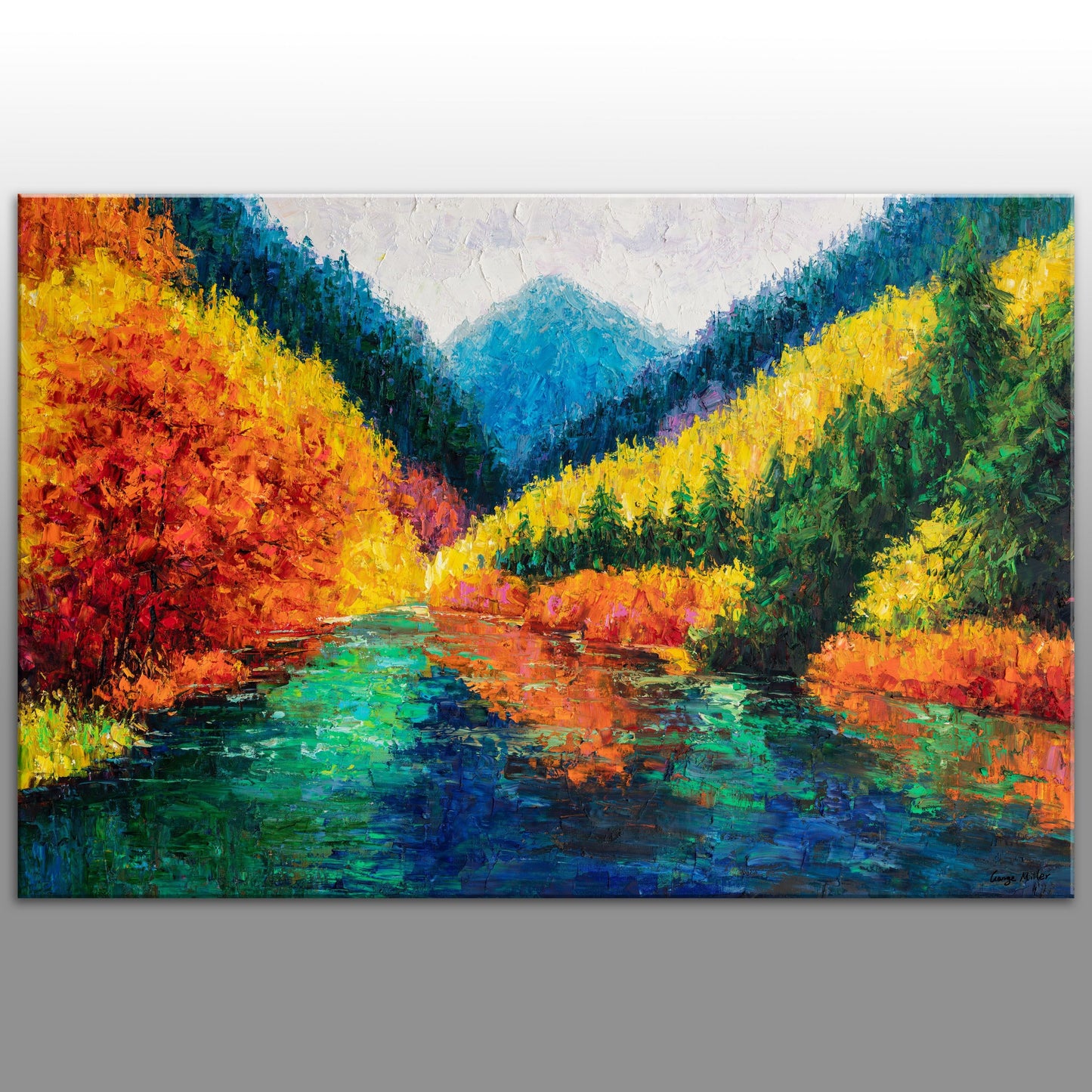The Advantages of Acquiring Oil Paintings: Why They Are a Timeless Financial investment
The benefits of acquiring oil paintings extend past plain appearances. These art work lug historic importance and social worth, making them beneficial enhancements to any type of collection. Their distinct structures and strategies add to an interesting aesthetic experience. In addition, recognized artists often see their work appreciate over time, presenting a prospective economic advantage - oil paintings for sale. As one discovers the diverse factors for purchasing oil paints, the deeper ramifications of such a selection become progressively obvious
The Visual Allure of Oil Paints
The attraction of oil paints hinges on their lively colors and rich textures, which can change any kind of area into a remarkable setting. These artworks have a deepness that mesmerizes visitors, drawing them right into the ins and outs of the brushstrokes and the interaction of light and darkness. The glossy surface of oil paint boosts the aesthetic experience, enlivening scenes and subjects in a manner that tools often can not achieve. Furthermore, the variety of designs-- from timeless to contemporary-- enables a varied selection that can complement any kind of decoration. The psychological resonance communicated with shade choices and strategies includes a layer of link in between the artwork and the observer, making oil paints not just attractive things, but effective expressions of creative vision.
Historic Importance and Cultural Value
Oil paints offer as crucial web links to a creative heritage, showcasing methods and designs that have progressed over centuries. They encapsulate cultural expressions and identities, reflecting the values and stories of their time. By obtaining these works, people add to the conservation of history and the appreciation of varied cultural heritages.
Imaginative Heritage Conservation
While many may forget the importance of imaginative heritage, purchasing oil paints plays a necessary function in preserving historic and cultural narratives. These art work serve as aesthetic documentation of their time, recording the significance of social worths, customs, and historical occasions. By obtaining oil paints, collection agencies contribute to the safeguarding of cultural heritages, ensuring that future generations can value and learn from these imaginative expressions. Each piece mirrors the unique tale of its maker and the context in which it was made. Furthermore, the continued admiration and display of oil paints in numerous setups help to cultivate an understanding of varied imaginative motions, enhancing the cultural landscape. Spending in oil paints is not simply an economic choice yet an act of social stewardship.
Social Expression and Identity
Art serves as a powerful tool for cultural expression and identification, showing the diverse stories that form cultures. Oil paints, particularly, capture the essence of cultural heritage, illustrating historical contexts and sociopolitical climates. Each brushstroke shares emotions and tales one-of-a-kind to certain practices, allowing audiences to engage with the artist's social background. This connection fosters a sense of belonging and understanding among different areas. In addition, oil paintings often function as visual documentation of cultural advancement, showcasing changes in identification with time. The financial investment in these art work not only supports musicians however also maintains cultural legacies, making them substantial possessions for enthusiasts. Eventually, oil paintings improve one's appreciation for the complexities of human experience and the rich tapestry of social identity.
Gratitude in Worth Gradually

The recognition of oil paints in time is affected by various aspects, including historical value fads that show transforming tastes and cultural importance. In addition, the track record of the musician plays a vital role in determining the artwork's market price, frequently boosting as the artist gains acknowledgment. Market need variations can further impact prices, making oil paints a possibly financially rewarding investment for enthusiasts.
Historical Value Patterns
As collectors seek to purchase tangible possessions, the historic worth patterns of oil paints reveal a compelling narrative of admiration with time. Historically, oil paintings have actually shown a regular upward trajectory in worth, particularly for jobs by established artists. Economic cycles and market demand have affected these fads, with durations of increased rate of interest commonly leading to significant rate rises. Auction documents often highlight the exceptional returns accomplished by iconic items, even more strengthening the notion of oil paints as sensible long-lasting investments. In addition, social motions and shifts in collector choices have sometimes spurred unexpected admiration, revealing that the art market, while somewhat uncertain, normally favors high quality oil paintings. Understanding these historic trends can assist investors in making notified decisions.
Musician Reputation Influence
While the reputation of an artist plays an essential duty in the gratitude of oil paints, it is very important to recognize that this influence can vary significantly based on several aspects. Developed artists, especially those with a substantial historical or social impact, tend to see their works appreciate extra swiftly. Conversely, lesser-known or arising musicians might not experience the same level of demand, influencing their art work's worth. Additionally, the musician's ability to develop a consistent body of job and keep importance in the art globe can affect long-term recognition. Enthusiasts often seek jobs from musicians that are recognized by credible galleries and institutions, which can additionally improve the worth of an oil paint gradually, making musician online reputation a vital consideration in investment choices.

Market Demand Fluctuations
Just how do market demand variations influence the recognition of oil paints with time? The value of oil paintings is inherently connected to market need, which can differ based on financial conditions, patterns, and collectors' preferences. In times of economic success, need commonly climbs, leading to raised prices as more buyers go into the market. Alternatively, throughout economic slumps, demand may decrease, causing worths to go stale or perhaps decline. Furthermore, the appeal of particular artists can move, impacting their work's charm. Inevitably, recognizing market need is essential for investors, as well-managed collections can value considerably with time, reflecting both the skill of the artist and the wider market dynamics. This interaction emphasizes the value of calculated purchasing in oil paint investments.
Distinct Textures and Strategies
Oil paints mesmerize customers with their unique structures and techniques, showcasing the musician's mastery over the tool. The thick application of paint, referred to as impasto, creates a three-dimensional result, inviting touch and boosting visual deepness. Artists typically employ various brush strokes, layering, and polishing approaches to attain luminous shades and elaborate information. This adaptability enables for rich contrasts and refined shifts, making each art work distinctively expressive. The slow-moving drying time of oil paint enables musicians to blend colors flawlessly, resulting in smooth slopes and lively shades. These techniques add to the painting's total character, making it a compelling focal factor. Each oil paint acts as an indicator of the imagination and skill inherent in standard imaginative practices.
Versatility in Home Style
The special textures and methods of oil paintings not only display creative ability however also enhance their adaptability in home decoration. These art work can perfectly match different interior designs, from modern minimalist to standard elegance. Oil paints function as focal points, attracting attention and sparking discussion among guests. Their rich colors and deepness can balance with different color palettes, making them versatile to altering layout trends. In addition, the psychological resonance of oil paintings can develop setting, whether it be heat in a cozy living space or vibrancy in an imaginative work space. By including oil paints, home owners elevate their rooms, changing them right into thoughtfully curated atmospheres that mirror individual taste and creative appreciation. Eventually, oil paints are a long-lasting option for boosting home visual appeals.
Connection to Prominent Musicians
While lots of art kinds can stimulate appreciation, acquiring oil paintings typically establishes an unique link to renowned musicians throughout background. Possessing an oil painting allows collection agencies to engage with the innovative visions of masters like Van Gogh, Monet, and Rembrandt. Each brushstroke personifies the musician's intentions, emotions, and methods, providing insight into their world. This connection transcends time, as each piece carries a story that mirrors the historic and cultural context of its production. Collectors not just obtain an artwork however also a fragment of the artist's heritage. As art enthusiasts explore the stories behind these paintings, they get a much deeper admiration for the workmanship and imaginative activities that formed their advancement, improving the value of their financial investment.
Psychological and psychological Advantages of Art
Art often functions as an effective stimulant for emotional and mental health. The existence of oil paintings in a living area can evoke a range of feelings, from harmony to ideas. Their intricate information and dynamic shades provide viewers a retreat, permitting representation and contemplation. Research studies recommend that involving with art can minimize anxiety and anxiousness, promoting a feeling of calm. Additionally, owning original artwork can develop an individual link, boosting sensations of satisfaction and happiness. This psychological bond often causes a much deeper admiration of one's surroundings, changing a home right into a home. Ultimately, the mental benefits of art prolong past visual appeals, adding to overall psychological health and wellness and enriching life experiences.

Frequently Asked Questions
Just how Do I Pick the Right Oil Painting for My Area?
Choosing the ideal oil paint entails thinking about the area's color pattern, dimension, and total aesthetic. One need to review personal preference, the painting's emotional impact, and how well it matches existing decoration prior to making a decision.

What Factors Impact the Worth of an Oil Painting?
The value of an oil painting is influenced by elements such as the musician's track record, provenance, historical significance, problem, market, and rarity need. Each component adds to total worth and charm amongst collectors.
How Can I Look After and Keep My Oil Paint?
To take care of and preserve an oil painting, one must consistently dust it with check here a soft fabric, avoid direct sunshine exposure, control humidity levels, and take into consideration professional cleaning to preserve its vibrancy and honesty.
Exist Specific Artists Known for Their Oil Paintings?
Countless artists are renowned for their oil paints - oil paintings for sale. Noteworthy figures include Vincent van Gogh, Claude Monet, and Rembrandt, each commemorated for their one-of-a-kind strategies and payments to the art globe through lively, textured oil mediums
Where Can I Acquisition Authentic Oil Paintings?
Genuine oil paintings can be bought from reputable galleries, art fairs, and on-line systems focusing on fine art. Collectors need to verify the credibility and provenance prior to buying to assure an important investment. Historically, oil paints have actually shown a regular upward trajectory in worth, especially for works by well established musicians. While the reputation of an artist plays an essential function in the recognition of oil paints, it is essential to identify that this effect can vary significantly based on several aspects. Oil paints astound audiences with their distinctive appearances and strategies, showcasing the artist's proficiency over the tool. While lots of art forms can evoke affection, buying oil paintings frequently establishes a special link to popular artists throughout background. The value of an oil paint is influenced by aspects such as the musician's track record, provenance, historic importance, rarity, market, and problem demand.